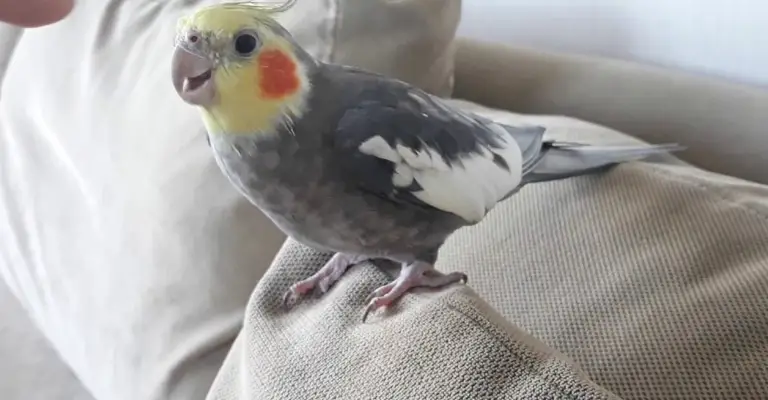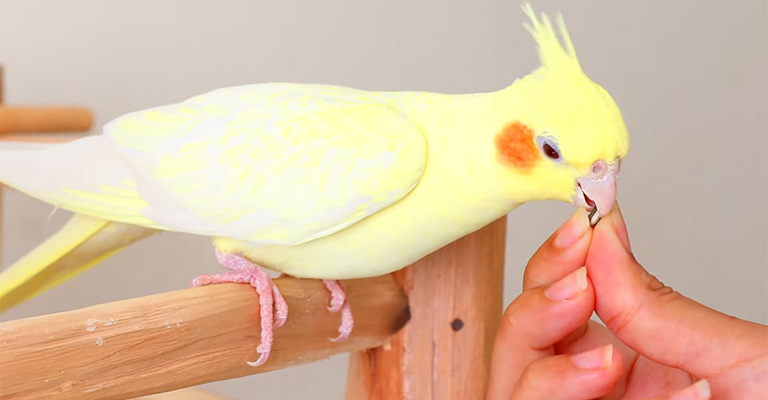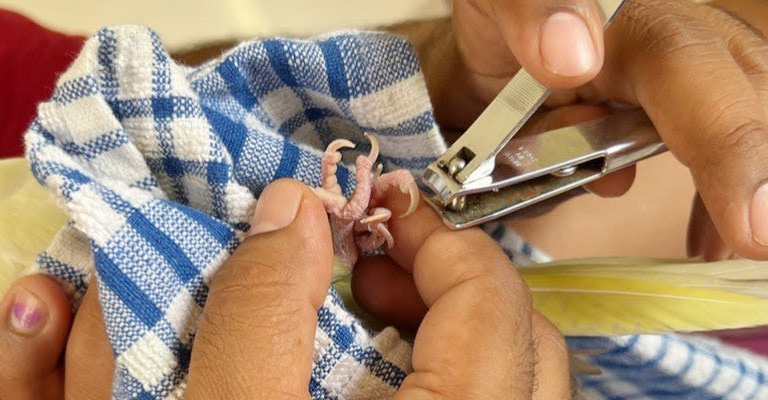Cockatiels, with their vibrant plumage and endearing personalities, make delightful companions. Yet, responsible pet ownership entails more than just love and attention. Proper grooming, like nail trimming, is essential for your cockatiel’s well-being.
In this comprehensive guide, we will walk you through the question of ‘How to clip a cockatiel’s nails?’. Whether you’re a seasoned bird owner or new to feathered friends, mastering this skill will ensure your pet’s safety, comfort, and overall health.
Nail trimming is not only about aesthetics but also about preventing potential hazards and discomfort.
The process requires precision and patience, and we’ll provide step-by-step instructions to make it a stress-free experience for both you and your feathered friend. So, stay focused till the end of this article.

When To Clip A Cockatiel’s Nails?
To maintain your cockatiel’s health and comfort, you should trim its nails as needed, typically every 4-6 weeks. The timing may vary based on the bird’s activity level and diet. Here are some signs that it’s time to clip your cockatiel’s nails:
Audible clicking
If you hear clicking sounds when your cockatiel walks on a hard surface, it’s a clear indication that the nails are too long.
Difficulty perching
If your bird struggles to grip perches or frequently slips, long nails may be the culprit.
Excessive scratching
Cockatiels use their beaks and feet to scratch, but if they’re frequently scratching their heads with their feet, it could mean their nails are too sharp.
Injury risk
Long nails can get caught in toys or fabric, potentially leading to injuries.
Ensure you use proper bird nail clippers and consult with an avian veterinarian or an experienced bird groomer if you’re unsure how to trim your cockatiel’s nails safely.
How To Clip A Cockatiel’s Nails?

Clipping a cockatiel’s nails requires care and precision to avoid injuring the bird. Here’s a step-by-step guide on how to clip a cockatiel’s nails:
Materials Needed
- Bird nail clippers or a nail file specifically designed for birds.
- A towel or cloth to help restrain the bird (optional).
- Styptic powder or cornstarch (in case of bleeding).
Procedure
- Prepare a quiet, well-lit, and comfortable space. Ensure the room is warm to keep your bird calm.
- If your cockatiel is not used to having its nails trimmed, you may want to enlist the help of a friend or family member to hold the bird gently but securely. Alternatively, you can wrap the bird in a small towel with its head exposed, leaving only one foot at a time accessible for trimming.
- Carefully examine each nail. Locate the pinkish vein called the “quick.” You should only trim the tip of the nail, avoiding the quick to prevent bleeding and pain.
- Trim the nail slowly and in small increments, taking extra care if your bird has dark-colored nails, as it can be more challenging to see the quick. Trim less than you think is necessary to be safe.
- If you accidentally cut into the quick and bleeding occurs, apply styptic powder or cornstarch to stop the bleeding. Press gently until the bleeding stops.
- Repeat this process for all the nails, one at a time.
- Always reward your cockatiel with treats and praise after the nail-clipping session to create positive associations with the experience.
- Monitor your bird’s nails regularly and trim as needed, typically every 4-6 weeks.
If you’re unsure about how to trim your cockatiel’s nails, consider having a veterinarian or an experienced bird groomer demonstrate the process or do it for you to ensure the safety and comfort of your pet.
Post Clipping Care for Cockatiels Nails

After clipping your cockatiel’s nails, it’s essential to provide post-care to ensure their comfort and well-being. Here are some steps to follow:
Inspect for Bleeding
Immediately after trimming, check each nail for any signs of bleeding. If you accidentally cut too close to the quick and bleeding occurs, apply styptic powder or cornstarch to stop the bleeding. Be gentle when doing this.
Offer Comfort
Your cockatiel might be a bit stressed after the nail-clipping session. Place them in a quiet and comfortable area with their favorite toys and treats to help them relax.
Monitor Behavior
Keep a close eye on your bird’s behavior and movement. Ensure they can perch comfortably without slipping or experiencing any distress.
Avoid Abrasive Surfaces
During the first day or two after nail trimming, avoid placing abrasive perches or surfaces in the cage to prevent any discomfort or potential injury to their freshly clipped nails.
Encourage Perching
Provide a variety of perches in the cage, including different diameters and textures, to encourage your cockatiel to use their feet and help maintain nail health.
Regular Checkups
Continue to monitor your cockatiel’s nails and be prepared to trim them again in about 4-6 weeks, depending on their growth rate and activity level.
Positive Reinforcement
Offer praise, attention, and treats to reward your cockatiel for their cooperation during the nail-clipping process. This will help create a positive association and make future sessions easier.
Consult a Professional
If you’re unsure about any aspect of nail clipping or if your cockatiel seems uncomfortable or in pain after the procedure, consult with an avian veterinarian or an experienced bird groomer for guidance and assistance.
Remember that proper nail care is essential for your cockatiel’s overall health and well-being. By following these post-clipping care steps and maintaining a regular nail-trimming schedule, you can help ensure your feathered friend stays happy and healthy.
Things to Consider When To Clip A Cockatiel’s Nails

When deciding when to clip a cockatiel’s nails, consider the following factors:
Nail Length
Regularly check your cockatiel’s nails to see if they appear long or overgrown. If the nails are approaching the point where they could impede the bird’s movement or cause discomfort, it’s time for a trim.
Activity Level
A more active cockatiel may naturally wear down its nails more quickly than a less active one. Pay attention to your bird’s behavior and how frequently it uses its feet for perching and climbing.
Diet and Nutrition
A healthy diet with appropriate amounts of vitamins and minerals can influence nail growth. Ensure your cockatiel is receiving a balanced diet to support overall feather and nail health.
Nail Care Equipment
Make sure you have the right tools for the job. Use bird-specific nail clippers or a nail file designed for birds. Dull or inappropriate tools can cause more harm than good.
Dark-Colored Nails
Cockatiels with dark-colored nails can be challenging to trim because it’s harder to see the quick. Exercise extra caution when trimming to avoid cutting into the sensitive quick.
Previous Experience
Consider your bird’s previous experiences with nail trimming. If your cockatiel has had negative experiences or is fearful, you may need to proceed slowly and use positive reinforcement to build trust.
Professional Assistance
If you’re unsure about when to trim your cockatiel’s nails or how to do it safely, seek help from an avian veterinarian or an experienced bird groomer. They can provide guidance and perform the nail trimming for you.
Frequency
Typically, cockatiel nails should be trimmed every 4-6 weeks, but individual needs may vary. Monitor your bird’s nails regularly to determine when they require attention.
Behavioral Changes
Watch for signs of discomfort or changes in your cockatiel’s behavior, such as excessive scratching or difficulty perching, which can indicate overgrown nails.
Health Conditions
Certain health conditions, such as arthritis, can affect a cockatiel’s ability to maintain its nails naturally. If your bird has underlying health issues, consult with a veterinarian for specialized nail care recommendations.
Taking these factors into account will help you determine the appropriate timing for nail trimming and ensure your cockatiel’s nails remain at a comfortable and safe length.
Safety Tips Regarding Clipping A Cockatiel’s Nails
Clipping a cockatiel’s nails requires care and attention to ensure the safety and comfort of your pet. Here are some safety tips to consider when clipping a cockatiel’s nails:
Proper Tools
Use bird-specific nail clippers or a nail file designed for birds. Ensure they are clean and sharp to make clean cuts. Avoid using human nail clippers or scissors, as they can crush and splinter the nail.
Good Lighting
Ensure you have proper lighting to clearly see the bird’s nails and the quick, especially if your cockatiel has dark-colored nails.
Gentle Restraint
If your cockatiel is not used to nail trimming, be gentle when restraining them. You may use a towel or cloth to wrap them with their head exposed, leaving one foot accessible at a time for trimming. Avoid squeezing or causing unnecessary stress.
Identify the Quick
Before cutting, identify the quick, which is the pinkish vein within the nail. Be cautious not to cut into it, as it can cause bleeding and pain.
Trim Gradually
Trim the nails in small increments. Start with just the tips to avoid cutting too close to the quick. You can always trim more if necessary, but you can’t undo a cut that’s too deep.
Styptic Powder
Have styptic powder or cornstarch on hand in case you accidentally cut into the quick. Applying a small amount will help stop bleeding. Gently press it onto the nail.
Take Breaks
If your cockatiel becomes stressed or agitated during the nail-trimming process, take breaks. It’s essential not to rush and to ensure the bird remains as calm as possible.
Positive Reinforcement
Reward your cockatiel with treats and praise after each nail is trimmed. This will create positive associations with the process.
Stay Calm
Remain calm and patient throughout the procedure. If you become anxious or agitated, your bird is more likely to react negatively.
Regular Maintenance
Establish a regular nail trimming schedule, typically every 4-6 weeks, to prevent overgrown nails. This will make the process easier and safer over time.
Seek Professional Help
If you’re unsure or uncomfortable about trimming your cockatiel’s nails, consult with an avian veterinarian or an experienced bird groomer. They can provide guidance and perform the procedure for you.
By following these safety tips, you can ensure that nail trimming for your cockatiel is a safe and stress-free experience for both you and your pet.
Benefits of Clipping A Cockatiel’s Nails
Clipping a cockatiel’s nails, when done correctly and with care, offers several benefits for both the bird and its owner:
Safety
One of the primary benefits of nail clipping is safety. Overgrown nails can lead to accidents, such as getting caught in toys, cage bars, or fabric, which may result in injury to the bird.
Comfort
Trimmed nails prevent discomfort for the cockatiel. Long nails can make it challenging for them to perch properly, leading to discomfort and even foot problems.
Improved Balance
Properly trimmed nails help maintain the bird’s balance, reducing the risk of falling and potential injuries.
Health
Maintaining appropriate nail length contributes to the overall health of your cockatiel. Overgrown nails can affect the bird’s posture and movement, potentially leading to musculoskeletal issues.
Hygiene
Shorter nails are easier to clean and maintain, reducing the risk of bacterial or fungal infections under the nails.
Behavior
Cockatiels with well-trimmed nails may be less prone to behavioral issues caused by discomfort or imbalance, such as excessive scratching.
Ease of Handling
Trimmed nails make it easier to handle your cockatiel without the risk of scratches or injuries to yourself.
Prevention of Self-Injury
Cockatiels often use their feet for grooming. Overgrown nails can inadvertently cause self-injury if they scratch too vigorously.
Reduced Stress
Routine nail clipping, when performed calmly and with positive reinforcement, can help your cockatiel become more accustomed to handling and reduce stress during grooming sessions.
Long-Term Health
Regular nail maintenance contributes to the long-term well-being of your cockatiel by preventing issues that can arise from neglecting nail care.
It’s important to emphasize that nail trimming should be done carefully to avoid cutting the quick, which can cause bleeding and discomfort.
If you’re unsure about how to trim your cockatiel’s nails, consider seeking guidance from an avian veterinarian or an experienced bird groomer to ensure the process is safe and comfortable for your pet.
FAQs
You should trim your cockatiel’s nails every 4-6 weeks on average. However, the frequency may vary depending on your bird’s activity level and nail growth rate.
No, it’s not recommended. Use bird-specific nail clippers or a nail file designed for birds to ensure a clean cut and avoid injuring the bird.
The quick is the pinkish vein within the nail. It’s important to be cautious and only trim the tip of the nail to avoid cutting into the quick, which can cause bleeding and pain.
Apply styptic powder or cornstarch to the bleeding nail to stop the bleeding. Gently press the powder onto the nail. If bleeding continues or if you’re uncertain, consult a veterinarian.
You can clip your cockatiel’s nails at home if you’re comfortable and have the right tools. However, if you’re unsure or your bird is particularly difficult, it’s wise to consult with an avian veterinarian or experienced bird groomer for guidance or assistance.
Wrapping Up
Caring for your cockatiel extends beyond offering them love and nourishment; it involves maintaining their physical well-being. Nail trimming, as we’ve discussed, is an integral aspect of this care.
By following the guidelines provided in this guide, you can ensure that your cockatiel’s nails remain at an appropriate length, promoting comfort and safety.
Remember, practice makes perfect. With time and experience, both you and your cockatiel will become more comfortable with the nail-clipping process. Regular maintenance will not only keep your pet’s nails in check but also strengthen the bond between you and your feathered companion.
So, embrace this aspect of responsible bird ownership, and watch your cockatiel flourish in a safe and nurturing environment. Thank you for being with us.